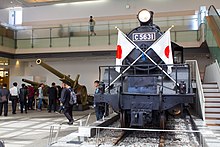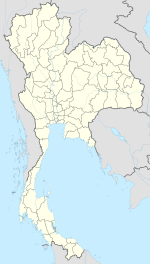Konkoita
Kaeng Khoi Tha | |
|---|---|
POW Camp | |
 Bridge building at Konkoita (1943) | |
| Coordinates: 14°56′43″N 98°32′36″E / 14.9453°N 98.5432°E | |
| Country | Thailand |
| Province | Kanchanaburi |
| District | Sangkhla Buri |
| Tambon | Nong Lu |
| Time zone | UTC+7 ( ICT) |
Konkoita ( Japanese: コンコイタ, originally from Karen; approximated in Thai as Kaeng Khoi Tha แก่งคอยท่า [1] or เกริงกวยทะ RTGS: Kroeng Kuai Tha [2]) is a former prisoner of war camp in the Sangkhla Buri District of the Kanchanaburi Province, Thailand. Located near the Karen village of Ban Kroeng Kruai, it was the location where the two sides of the Burma Railway met on 17 October 1943 at 262.87 kilometres from the starting point in Thailand. Konkoita and neighbouring villages were flooded in June 1984 by the construction of the Vajiralongkorn Dam. The population in the area was resettled several kilometres from the original villages.
Burma Railway
In 1939, plans had been developed by the Empire of Japan to construct a rail road connecting Thailand with Burma. Construction of the Burma Railway started on 16 September 1942. [3] On 9 May 1943, the first 700 prisoners of war arrived at Konkoita to build the railway, and started building three work camps. [4] On 15 May, there was a cholera outbreak at Shimo Nicke (Shimo Ni Thea). An advice by the British commander Colonel Harris to the Japanese Lieutenant colonel Banno to stop transit parties into Konkoita was not heeded, and cholera spread over five camps. [5] In August construction started on a large trestle bridge near Konkoita. [6]
On 17 October 1943, both sides of the Burma Railway met near Konkoita at 262.87 kilometres from the Thai, and 152.13 kilometres from the Burmese starting point. [7] The meeting point was about 18 kilometres (11 mi) south of the border at Three Pagodas Pass. [1] A holiday was declared for 25 October which was chosen as the ceremonial opening of the line. [7] [8] The Japanese staff would travel by train C56 31 from Nong Pladuk, Thailand to Thanbyuzayat, Burma. A copper spike was driven at the meeting point by commanding General Eiguma Ishida, [9] and a memorial plaque was revealed. [8]

The construction of the Burma Railway had taken 16 months, [10] and had resulted in approximately 100,000 deaths. [11] The prisoners of war were moved from the jungle camps to base camps from where many were transported to Japan. Many of the Asian forced labourers stayed behind and were tasked to maintain the line. [10] The first train to pass the line was moved to the Yasukuni Shrine in Tokyo where it is displayed without mentioning the human cost of the railway line. [8]
In September 1945, there was a railway accident which caused the collapse of the bridge near Konkoita. [12] In October 1946, the Thai section of the line was sold to the Government of Thailand for £1,250,000. The money was used to compensate neighbouring countries and colonies for material stolen by Japan during the construction of the railway. [13] On 1 February 1947, two people including Momluang Kri Dechatiwong, the Minister of Transport, were killed on an inspection tour 500 metres before Konkoita station. Their trolley was supposed to pass over the bridge after a curve, however it had burned down and collapsed causing the trolley to drop 8.5 metres. [14] [15] After the accident, it was decided to end the line at Nam Tok and reuse the remainder to rehabilitate the line. [16]
Vajiralongkorn Dam

In the 1980s, it was decided to build the Vajiralongkorn Dam on the Khwae Noi River to generate hydroelectricity. [17] Konkoita, the neighbouring Mon village of Sangklaburi, [8] and several other villages were flooded in June 1984 by the construction of the dam. The population was resettled several kilometres from the original sites. [18] The meeting point and about 50 kilometre of railway is now submerged, and the memorial has been moved to higher ground. [8] A hospital built in 1963 in Sangklaburi was rebuilt in Huay Malai where it served two refugee camps along the Myanmar border in the 2010s. [18]
References
- ^ a b "The Burma Railway (video)". Online Burma/Myanmar Library. Retrieved 30 January 2022.
- ^ รถยนต์รางเลขที่ 2512 [Rail Car No. 2512] (information sign) (in Thai). Wang Pho Railway Station: State Railway of Thailand.
- ^ "The Thailand-Burma Railway". PBS. 26 June 2008. Retrieved 30 January 2022.
- ^ "Konkoita". Japanse Krijgsgevangenkampen (in Dutch). Retrieved 30 January 2022.
- ^ Cyril Wild. "Report of Condition of P.O.Ws in Thailand". Far East POW Family. Retrieved 30 January 2022.
- ^ "Upper Konkoita". Far East POW Family. Retrieved 30 January 2022.
- ^ a b "Meeting Point". Far East POW Family. Retrieved 30 January 2022.
- ^ a b c d e "8.12 Konkoita mtg point". US POWs Thai-Burma Railway. Archived from the original on 30 January 2022. Retrieved 30 January 2022.
- ^ "Ishida Eiguma and others". Singapore War Crimes Trials. Retrieved 30 January 2022.
- ^ a b "A brief history of the Thailand-Burma Railway". Grand Valley State University. Retrieved 30 January 2022.
- ^ Neil MacPherson. "Death Railway Movements". Mansell.com. Retrieved 27 January 2022.
- ^ "Konkoita". Far East POW Family. Retrieved 30 January 2022.
- ^ "Burma-Siam railway sold". Western Star and Roma Advertiser. 11 October 1946. Retrieved 30 January 2022.
- ^ B. R. Whyte (2010). The Railway Atlas of Thailand, Laos and Cambodia. pp. 69–70. ISBN 978-974-480-157-9.
- ^ "Death plunge On Burma Railway". Maryborough Chronicle, Wide Bay and Burnett Advertiser. 7 February 1947.
- ^ "Date & Events of Railway in Thailand". Rot Fai Thai. Retrieved 30 January 2022.
- ^ "Vajiralongkorn Dam". Electricity Generating Authority of Thailand. Archived from the original on 29 January 2022. Retrieved 30 January 2022.
- ^ a b Phil McDaniel. "The Changing Face of KRCH". Kwai River Christian Hospital. Retrieved 30 January 2022.
